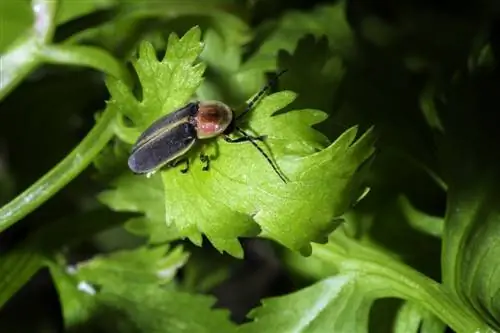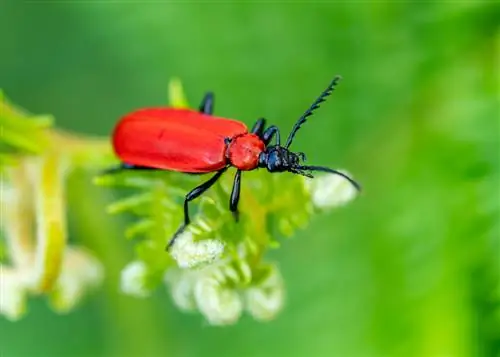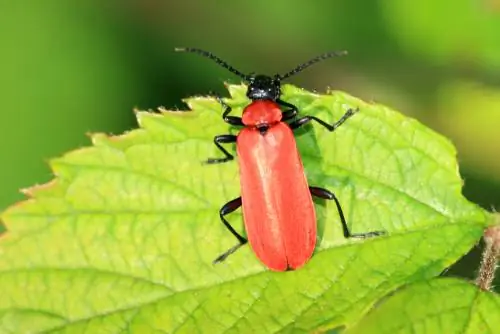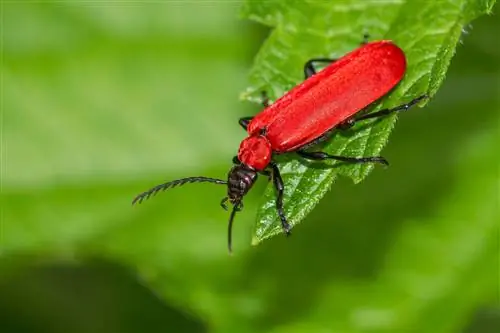- Author admin [email protected].
- Public 2023-12-16 16:46.
- Last modified 2025-01-23 11:22.
This species looks dangerous at first glance because the elytra shine in intense colors. There are some species that cause confusion among laypeople. But upon closer inspection, this beetle can be clearly identified.
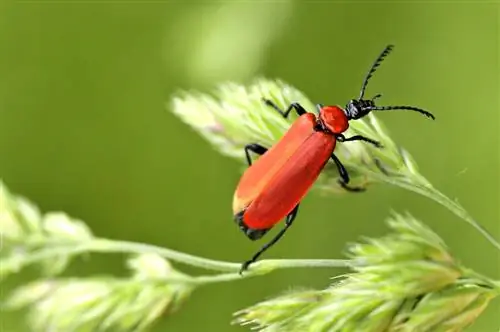
Is the Scarlet Fire Beetle dangerous or useful?
The scarlet fire beetle (Pyrochroa coccinea) is a harmless, beneficial beetle found in Europe. The bright red beetle feeds on sweet liquids such as honeydew and tree sap, while its larvae eat insect larvae and fungal tangles in dead wood. Control measures are not necessary.
How to recognize the animals
The fire beetles or cardinals represent a family that includes about 140 species. Three members of the family are native to Germany, with Pyrochroa coccinea often being observed. This beetle is characterized by an elongated and flat body. It reaches a length of approximately two centimeters and shines in scarlet shades. The head is completely black in color. The antennae are striking, which are sawn in females and combed in males.
Possible confusion
- Lily chicken: has no fanned antennae
- Red-headed fire beetle: has a clear red color on the head
- Firebug: with distinct black-red pattern
Larval stage
The offspring have a flattened shape and are bright yellow in color. Two thorns are noticeable at the end of the abdomen. It takes two to three years for the larva to pupate and emerge from the cocoon as a fully developed specimen. In this final stage, the animals rarely eat.
Occurrence and appearance
This species is distributed across the entire European continent. Their distribution area extends north to central Sweden, central Finland and southern Norway. Because of their food, they prefer wooded areas with areas of dead wood. Their main flight time is between May and June. The animals are less likely to be found in gardens if the property is near a forest.
Useful beetles
While adults feed on sweet liquids such as honeydew and tree sap, their larvae prove to be real beneficial insects. They live in dead wood and under tree bark. There the predators not only eat fungal lichens, but also beetle larvae and insects. The bark beetle lava takes a place on the menu.
Are fire beetles dangerous?
Red colors represent a warning signal in the animal world. They signal to potential predators that they are inedible or poisonous. Pyrochroa coccinea also uses its red color to try to protect itself by misleading predators. It is completely harmless to humans. The beetle is unable to pierce the skin with its mouthparts. There is also no evidence of toxic effects on human he alth.
Are control measures necessary?
The adult cardinals do no damage to crops or ornamental plants. They live where aphids live and plant juices escape from open wounds on the tree. To get their food, they do not destroy plant tissue. Combating it therefore makes no sense. The larvae also do not cause any damage because they do not decompose the wood. Because of their preference for insect larvae, they can be viewed as beneficial insects.


